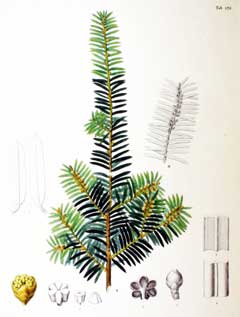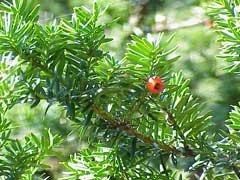 |
|
http://commons.wikimedia.org/wiki/File:Taxus_cuspidata_SZ128.png |
 |
| http://www.kurtstueber.de/ |
Translate this page:
Summary
Bloom Color: Green, Yellow. Main Bloom Time: Early spring, Late spring, Mid spring. Form: Pyramidal, Rounded.
Physical Characteristics

 Taxus cuspidata is an evergreen Tree growing to 10 m (32ft) by 10 m (32ft) at a slow rate.
Taxus cuspidata is an evergreen Tree growing to 10 m (32ft) by 10 m (32ft) at a slow rate.
See above for USDA hardiness. It is hardy to UK zone 6 and is not frost tender. It is in leaf all year, and the seeds ripen from September to November. The species is dioecious (individual flowers are either male or female, but only one sex is to be found on any one plant so both male and female plants must be grown if seed is required). and is pollinated by Wind. The plant is not self-fertile.
Suitable for: light (sandy), medium (loamy) and heavy (clay) soils and prefers well-drained soil. Suitable pH: mildly acid, neutral and basic (mildly alkaline) soils and can grow in very acid and very alkaline soils.
It can grow in full shade (deep woodland) semi-shade (light woodland) or no shade. It prefers dry or moist soil. The plant can tolerates strong winds but not maritime exposure.
It can tolerate atmospheric pollution.
UK Hardiness Map
US Hardiness Map
Synonyms
Plant Habitats
Woodland Garden Sunny Edge; Dappled Shade; Shady Edge; not Deep Shade;
Edible Uses
Edible Parts: Fruit
Edible Uses:
Fruit - raw or made into jam[105, 183]. Very sweet and gelatinous, most people find it delicious though some find it sickly. The fruit is a fleshy berry about 8mm in diameter and containing a single seed[200]. All other parts of this plant, including the seed, are highly poisonous. When eating the fruit you should spit out the large seed found in the fruit's centre. Should you swallow the whole seed it will just pass straight through you without harm, if the seed has been bitten into, however, it could cause some problems.
References More on Edible Uses
Medicinal Uses
Plants For A Future can not take any responsibility for any adverse effects from the use of plants. Always seek advice from a professional before using a plant medicinally.
Cancer
Modern research has shown that yew trees contain the substance 'taxol' in their shoots and bark. Taxol has shown exciting potential as an anti-cancer drug, particularly in the treatment of ovarian cancers[218, 238]. This remedy is very toxic and, even when used externally, should only be used under the supervision of a qualified practitioner[238]. See also the notes above on toxicity. A compound used to treat diabetes is extracted from the wood, bark, leaves, and roots[266].
References More on Medicinal Uses
The Bookshop: Edible Plant Books
Our Latest books on Perennial Plants For Food Forests and Permaculture Gardens in paperback or digital formats.

Edible Tropical Plants
Food Forest Plants for Hotter Conditions: 250+ Plants For Tropical Food Forests & Permaculture Gardens.
More

Edible Temperate Plants
Plants for Your Food Forest: 500 Plants for Temperate Food Forests & Permaculture Gardens.
More

More Books
PFAF have eight books available in paperback and digital formats. Browse the shop for more information.
Shop Now
Other Uses
Dye Wood
A brown dye is obtained from the heartwood[46, 61]. Red according to another report[266]. An oil is extracted from the seeds[266]. Wood - hard, strong, elastic, fine grained, takes a beautiful polish. Used for furniture, bows etc[1, 46, 61]. The wood is used in building construction, furniture manufacture and as a carving material[266].
Special Uses
Food Forest
References More on Other Uses
Cultivation details
Landscape Uses:Hedge, Screen, Superior hedge, Specimen. Thrives in almost any soil, acid or alkaline, as long as it is well-drained[1, 200]. Succeeds in dry soils[188]. Very shade tolerant[81]. The dormant plant is hardy to about -35°c[200] but it requires more summer heat and humidity than T. baccata and is rarely more than a shrub in Britain[81]. Young shoots can be damaged by late spring frosts. The foliage may turn reddish-brown in cold winters[81]. There are several named varieties selected for their ornamental value[188]. Plants produce very little fibrous root and should be planted in their final positions when still small[200]. Plants in this genus are notably resistant to honey fungus[200]. Dioecious. Male and female plants must be grown if fruit and seed is required. Female plants fruit freely in Britain if they are pollinated[11, 185]. Special Features:Not North American native, All or parts of this plant are poisonous, Inconspicuous flowers or blooms.
References Carbon Farming Information and Carbon Sequestration Information
Temperature Converter
Type a value in the Celsius field to convert the value to Fahrenheit:
Fahrenheit:
The PFAF Bookshop
Plants For A Future have a number of books available in paperback and digital form. Book titles include Edible Plants, Edible Perennials, Edible Trees,Edible Shrubs, Woodland Gardening, and Temperate Food Forest Plants. Our new book is Food Forest Plants For Hotter Conditions (Tropical and Sub-Tropical).
Shop Now
Plant Propagation
Seed - can be very slow to germinate, often taking 2 or more years[78, 80]. It is best sown as soon as it is ripe in the autumn when it should germinate 18 months later. Stored seed may take 2 years or more to germinate. 4 months warm followed by 4 months cold stratification may help reduce the germination time[113]. Harvesting the seed 'green' (when fully developed but before it has dried on the plant) and then sowing it immediately has not been found to reduce the germination time because the inhibiting factors develop too early[80]. Prick out the seedlings into individual pots once they are large enough to handle and grow them on in pots in a cold frame. The seedlings are very slow-growing and will probably require at least 2 years of pot cultivation before being large enough to plant out. Any planting out is best done in late spring or early summer, after the last expected frosts[K]. Cuttings of half-ripe terminal shoots, 5 - 8cm long, July/August in a shaded frame. Should root by late September but leave them in the frame over winter and plant out in late spring[78]. High percentage[11]. Cuttings of ripe terminal shoots, taken in winter after a hard frost, in a shaded frame[113].
Other Names
If available other names are mentioned here
Native Plant Search
Search over 900 plants ideal for food forests and permaculture gardens. Filter to search native plants to your area. The plants selected are the plants in our book 'Plants For Your Food Forest: 500 Plants for Temperate Food Forests and Permaculture Gardens, as well as plants chosen for our forthcoming related books for Tropical/Hot Wet Climates and Mediterranean/Hot Dry Climates. Native Plant Search
Found In
Countries where the plant has been found are listed here if the information is available
Weed Potential
Right plant wrong place. We are currently updating this section.
Please note that a plant may be invasive in one area but may not in your area so it’s worth checking.
Conservation Status
IUCN Red List of Threatened Plants Status :

Growth: S = slow M = medium F = fast. Soil: L = light (sandy) M = medium H = heavy (clay). pH: A = acid N = neutral B = basic (alkaline). Shade: F = full shade S = semi-shade N = no shade. Moisture: D = dry M = Moist We = wet Wa = water.

Expert comment
Author
Siebold.&Zucc.
Botanical References
1158200
Links / References
For a list of references used on this page please go here
Readers comment
| Add a comment |
|
If you have important information about this plant that may help other users please add a comment or link below. Only comments or links that are felt to be directly relevant to a plant will be included. If you think a comment/link or information contained on this page is inaccurate or misleading we would welcome your feedback at [email protected]. If you have questions about a plant please use the Forum on this website as we do not have the resources to answer questions ourselves.
* Please note: the comments by website users are not necessarily those held by PFAF and may give misleading or inaccurate information.
To leave a comment please Register or login here All comments need to be approved so will not appear immediately.
|
Subject : Taxus cuspidata
|
|
|
|